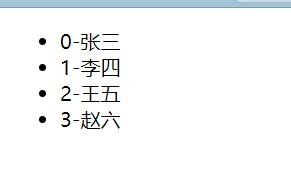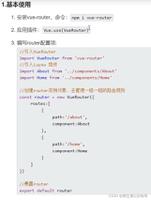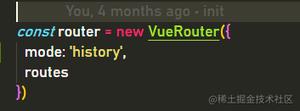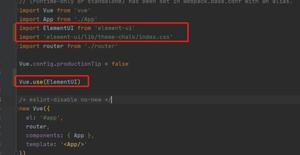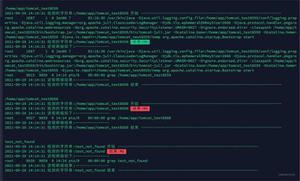【小慕读书】—— 后台管理系统学习:Vuex 和 Vue-router 进阶

前言:最近在学习Vue+Element UI+Node.js小慕读书中后台管理系统开发课程,这里对学习过程作个笔记,方便自己和大家翻阅。
一、Vuex 原理解析
Vuex 的原理关键:使用 Vue 实例管理状态
<body><div >{{data}}</div>
<div >{{data2}}</div>
<div >
<button @click="change">change</button>
</div>
<script>
function registerPlugin(Vue) {
const vuex = {}
vuex._vm = new Vue({ //_vm是Vue实例
data: {
message: 'hello vue.js'
}
})
vuex.state = vuex._vm
vuex.mutations = {
setMessage(value) {
vuex.state.message = value
}
}
function init() {
this.$store = vuex
}
Vue.mixin({ //全局的mixin
beforeCreate: init
})
}
Vue.use(registerPlugin)
new Vue({
el: '#root',
computed: {
data() {
return this.$store.state.message
}
}
})
new Vue({
el: '#root2',
computed: {
data2() {
return this.$store.state.message
}
}
})
new Vue({
el: '#root3',
methods: {
change() {
const newValue = this.$store.state.message + '.'
this.$store.mutations.setMessage(newValue) //Vue响应式 前两个Vue实例的message都会变化
}
}
})
</script>
</body>
二、router" title="vue-router">vue-router 实现原理
vue-router 实例化时会初始化 this.history,不同 mode 对应不同的 history
constructor (options: RouterOptions = {}) { this.mode = mode
switch (mode) {
case 'history':
this.history = new HTML5History(this, options.base)
break
case 'hash':
this.history = new HashHistory(this, options.base, this.fallback)
break
case 'abstract':
this.history = new AbstractHistory(this, options.base)
break
default:
if (process.env.NODE_ENV !== 'production') {
assert(false, `invalid mode: ${mode}`)
}
}
}
这里以 HashHistory 为例,vue-router 的 push 方法实现如下: (实际调用的是Hashhistory的push方法)
push (location: RawLocation, onComplete?: Function, onAbort?: Function) { // $flow-disable-line
if (!onComplete && !onAbort && typeof Promise !== 'undefined') {
return new Promise((resolve, reject) => {
this.history.push(location, resolve, reject)
})
} else {
this.history.push(location, onComplete, onAbort)
}
}
HashHistory 具体实现了 push 方法:
function pushHash (path) { if (supportsPushState) {
pushState(getUrl(path))
} else {
window.location.hash = path
}
}
对路由的监听通过 hash 相应的事件监听实现:
window.addEventListener(supportsPushState ? 'popstate' : 'hashchange',
() => {
const current = this.current
if (!ensureSlash()) {
return
}
this.transitionTo(getHash(), route => {
if (supportsScroll) {
handleScroll(this.router, route, current, true)
}
if (!supportsPushState) {
replaceHash(route.fullPath)
}
})
}
)
除此之外,vue-router 还提供了两个组件:
Vue.component('RouterView', View)Vue.component('RouterLink', Link)
三、vue-router 路由守卫
创建 router.js:
import Vue from 'vue'import Route from 'vue-router'
import HelloWorld from './components/HelloWorld'
Vue.use(Route)
const routes = [
{ path: '/hello-world', component: HelloWorld }
]
const router = new Route({
routes
})
export default router
在 main.js 中引用 router,并加入 vue 实例:
import router from './router'new Vue({
render: h => h(App),
router
}).$mount('#app')
四、全局守卫
进入每一个路由都会触发的钩子函数
注意:因为写在vue-router中,所以全局守卫都是没有办法获得Vue实例的。
//router.js
router.beforeEach((to, from, next) => { //当路由进入之前可以触发的操作console.log('beforeEach', to, from)
next()
})
router.beforeResolve((to, from, next) => { //当路由被解析之前被调用 Vue2.5新特性
console.log('beforeResolve', to, from)
next()
})
router.afterEach((to, from) => { //当路由进入之后可以触发的事件
console.log('afterEach', to, from)
})
整个路由守卫执行是在组件生命周期函数之前的:
beforeEach(全局守卫)、befforeResolve(全局守卫)、afterEach(全局守卫)
beforeCreate、created、beforeMount、mouted
五、局部守卫
只适合在当前路由使用,是局部的路由守卫。(写在和组件的生命周期函数同一级)
1.to:表示当前路由,即要进入的路由
2.from:表示从哪来的,
3.next() 表示下一步要干啥,next('/addGoods')就表示下一步,调到路由 /addGoods
//A.vue
beforeRouteEnter (to, from, next) { //在需要进入的组件中调用// 不能获取组件实例 `this`, 因为在组件生命周期beforeCreate之前
console.log('beforeRouteEnter', to, from)
next()
},
beforeRouteUpdate (to, from, next) { //在复用(更新)的组件中调用
console.log('beforeRouteUpdate', to, from)
next()
},
beforeRouteLeave (to, from, next) { //在离开的组件中调用
console.log('beforeRouteLeave', to, from)
next()
}
进入组件:beforeEach(全局守卫)、beforeRouteEnter(局部守卫)、beforeResolve(全局守卫)、afterEach(全局守卫)、beforeCreate、created、beforeMount、mounted
- 更新组件:beforeEach(全局守卫)、beforeRouteUpdate(局部守卫)、beforeResolve(全局守卫)、afterEach(全局守卫)
离开组件:beforeRouteLeave(局部守卫)、beforeEach(全局守卫)、beforeResolve(全局守卫)、afterEach(全局守卫)、 beforeDestory
六、路由元信息
通过 meta 定义路由元信息
const routes = [{ path: '/a', component: A, meta: { title: 'Custom Title A' } }
]
使用 meta 信息动态修改标题
(和路由相关的功能,推荐放在路由的全局守卫中实现)
router.beforeEach((to, from, next) => { console.log('beforeEach', to, from)
if (to.meta && to.meta.title) {
document.title = to.meta.title
} else {
document.title = 'default title'
}
next()
})
七、路由 API
使用 router.addRoutes 动态添加路由
使用场景:菜单路由的权限赋值
addRoute() { this.$router.addRoutes([{
path: '/b', component: B, meta: { title: 'Custom Title B' },
}])
}
此时可以访问到 B 组件
<router-link to='/b'>to B</router-link>
注:项目来自慕课网
以上是 【小慕读书】—— 后台管理系统学习:Vuex 和 Vue-router 进阶 的全部内容, 来源链接: utcz.com/z/379016.html

